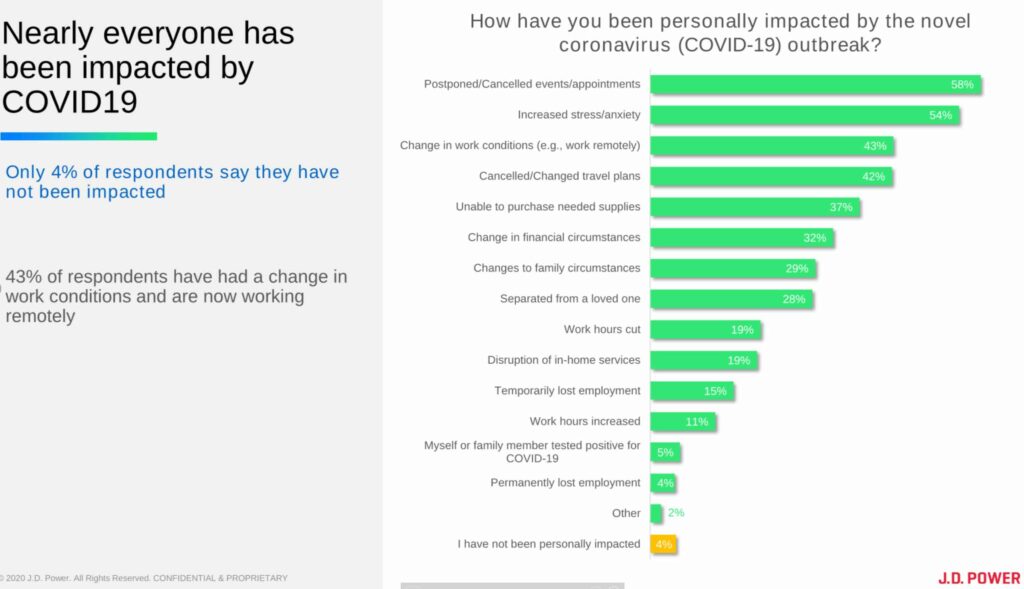User Feedback: The Sudden Ubiquity of the Virtual Meeting
Everyone is talking about the new normal. It’s a world where online is a lifeline and IT is keeping business flowing even though office buildings are empty. We’re all having to discover new ways to live, work, and interact.
Virtual meetings suddenly became ubiquitous overnight. They’re now woven into every aspect of our lives. And it’s not just work meetings and family gatherings. News shows, gym classes, and D.J. dance parties are happening on video platforms. Saturday Night Live’s first remotely-produced show even included a cringe-worthy spoof of a work-from-home meeting.
This enormous global stress test is producing some interesting data on how we use online meeting platforms. A month after U.S. colleges and businesses began sending their people home to learn, teach, and work, J.D. Power fielded a survey to discover how different platforms are perceived.
See the full results of this survey here or flip through the slides at the bottom of this post.
Adapting to the Virtual Life
While it’s sobering news that nearly all of J.D. Power’s survey respondents had been impacted in some way by COVID-19, many were rapidly adapting to life in quarantine. Most people now have no choice but to keep in touch with clients, colleagues, and family through virtual channels. Users who are already familiar with the features and interface of a video platform have been coaching others through their first meetings, accelerating adoption of these services.
At the time of the J.D. Power survey in early April, 2020, 43% of respondents had already experienced a change in work conditions and were working from home. Nearly two thirds had used an online meeting platform that week. This provided a large pool of users to give feedback on their meeting experience.
Uncovering Opportunities for a Better User Experience
Reliability and ease of use will be in the spotlight now that online meeting platforms are in high demand. J.D. Power found that the most common complaints were related to user error like participants fumbling with the mute button. These issues will likely dissipate with continued practice. However, other complaints point to a need for improved platform reliability – users reported garbled audio, lag, lost connections, and other problems with audio or video. As people try out a variety of platforms, they’ll gravitate toward their favorites based on real as well as perceived strengths and weaknesses.
Platform Variety Without Brand Loyalty
J.D. Power found that more than half the people they spoke to were using two or more online meeting platforms. Outside their office infrastructure, workers are discovering what works best in their home environment. They’re also flexing to accommodate friends or colleagues who use different tools. Pricing and features will influence which platform is chosen for personal versus business use.
Survey data reflects the fact that online meeting platforms have focused their strategies on the needs of different market segments. Teams, Webex, and GoToMeeting are being used nearly exclusively for business purposes. Already sensing an opportunity, Microsoft announced this month that Teams will be available for the home market through specially priced personal and family plans.

Zoom, the most popular platform, is relied upon equally for personal and business connections, according to survey data. The overnight adoption of Zoom for education and small business use has created new segments of video meeting fans. This doesn’t necessarily translate to brand loyalty. Collaboration and document sharing tools are likely to entice teachers, students, and work groups to a more robust cloud-based platform like Microsoft Teams.
No Need to Wait on Migrating to the Cloud
While all this isn’t much of a surprise, at BitTitan we are seeing an acceleration of cloud migrations to support work-from-home activities as well as business continuity. In the initial weeks of the pandemic, some MSPs had clients putting projects on hold. Now many customers are pressing for more urgent completion timelines. If your company needs to migrate to the cloud to support your distributed workforce, we’ve assembled a toolkit with tips and best practices that will allow you to shortcut the initial phases.
Many of us at BitTitan are working from home as well, but we’re always happy to consult with you using your favorite online meeting platform. An old fashioned phone call works, too! The good news is that much of the IT work needed for cloud migrations can be done remotely with BitTitan’s SaaS-based technology.
MigrationWiz makes it easy to migrate to the cloud and support work-from-home teams. Contact us today!


